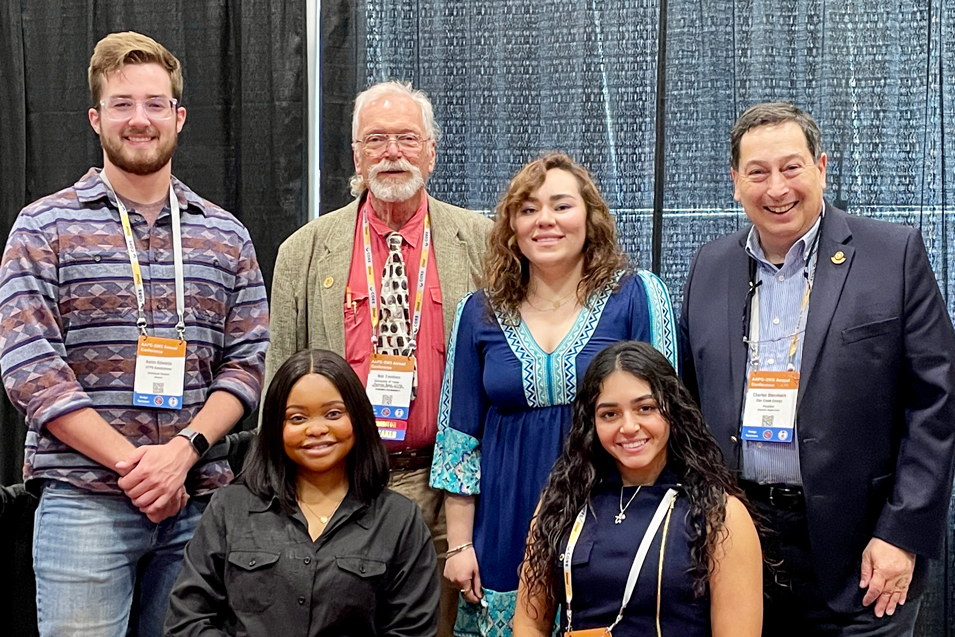
The AAPG Convention explored a four-dimensional multiverse of geology and reservoirs, combining regional overviews with multi-scale measurements of rocks and sediments, and analyzing rocks in the fourth dimension of geologic time.
The result is “Resology.” General Chair Ben Davis defines Resology as “the study of geology and rock reservoirs at big and small scales.” He told conference attendees, “The goal of Resology is effective and efficient hydrocarbon production.”
The meeting successfully reflected the integrated nature of the West Texas oil business. In this dusty town of Midland, teams of geologists, engineers, petrophysicists and geophysicists work together to integrate models and data describing heterogeneous carbonate and clastic reservoirs.
The Convention drew in 375 attendees and a fair number of exhibitors to the Horseshoe Arena Center. Along with David, key organizers included President Paul Pause, incoming Section President Jerry Hickman and technical co-chairs Judd Tudor and Yogashri Pradhan. Incoming Section President-Elect John Stroud hosted the awards portion of the opening session before the icebreaker.
“Drilling and oil production are climbing in the Permian Basin. If you’re not exploring in the Permian Basin, you’re missing a huge opportunity,” said Pause in his welcome message.
Program Highlights
Highlights from the technical program included a surprising new study into plate tectonics and hot spots masterfully explained by keynote speaker John Dvorak, who is an author and a volcanic and planetary geologist.
Old 1960s-era ideas about plate tectonics are being upended by groundbreaking research into core-mantle boundary using 3-D seismic tomography, he explained. Drawing from his new book, “How the Mountains Grew,” Dvorak explained how descending plates created two core-mantle megapiles called “Tuzo” and “Jason” (named after famous geologists), which have influenced subsidence in intracratonic basins like the Permian and present-day volcanic hotspots. “Delamination” of crustal material also causes intraplate uplifts. These deep megapiles also explain mantle plumes and accumulations of metals and minerals (yes, we mean gold, diamonds and rare Earth elements) in the shallow crust.
Copies of Dvorak’s book flew into attendees’ hands at a Monday book signing.
Andy Pepper got the synergy started with a pre-convention short course called “Introduction to Fluid Saturations and Properties in Unconventional Shale Reservoirs.” The SWS Convention featured more groundbreaking talks on regional tectonics.
Alton Brown spoke on “Regional Controls on Pennsylvanian Fort Worth Basin and Eastern Shelf Deposition North-Central Texas,” tying in 4-D geology and sedimentation patterns from the Midland Basin, the Ouachita uplift and the Arkoma Basin.
Tom Ewing spoke on “Basement Framework of the West Texas Basin and the Inception of the Tobosa basin,” synthesizing regional gravity covering Llano uplift, the Permian Basin and southwestern New Mexico.
The Texas Bureau of Economic Geology Tight Oil Resource Assessment program contributed nine geology and economic summaries and assessments. TORA Key innovations include basin-scale geologic modeling, an evolving integrated workflow, a 3-D analysis of well landing zones for horizontal wells and a data analytics/machine learning methodology to estimate technically recoverable resources.
All Convention Luncheon speaker Jeffrey May of the Colorado School of Mines and formerly EOG Resources chief geologist, delivered his expertise on “Using Sequence Stratigraphy to Optimize Target Selection in Unconventional Reservoirs.” May stumped the audience with a correlation problem of well logs in mudrocks during his luncheon talk. He explained how the unconventional reservoir correlation could be accurately accomplished using seismic, paleontology and sequence stratigraphy concepts pioneered by Peter Vail in the 1970s. Mastering stratigraphic correlation improves landing zone accuracy and reservoir management.
The Midland area has several groups of students preparing for oil and environment geo-careers. The University of Texas at the Permian Basin students presented posters and arranged an exhibition booth. UTPB professor Bob Trentham gave a talk on a carbon utilization and storage project called CUSP that will optimize the use of CO2 in enhanced oil recovery.
Gary Rice of GeoFrontiers spoke about helium exploration. Rice told the audience that helium costs the consumer $300 per thousand cubic feet. Helium and hydrogen are rare non-petroleum gases found in the Permian Basin.
The meeting in 2023 will be in Wichita Falls, Texas, May 6-9, hosted by the North Texas Geological Society, celebrating its 100th year in ‘23. A dinosaur graces the logo of NTGS, so that might be a clue to future field trips.